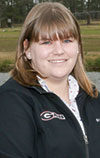Most hay producers in the Southeast irrigate their hayfields on a set schedule to provide 1/2 – 1 inch per week. Unfortunately, in a drought year, this level of irrigation may not be sufficient to replace water lost through evapotranspiration.
Lack of existing research
Most hay producers in the Southeast irrigate their hayfields on a set schedule to provide 1/2 – 1 inch per week. Unfortunately, in a drought year, this level of irrigation may not be sufficient to replace water lost through evapotranspiration.
Most forage irrigation research has been conducted in semi-arid to arid environments common to the western U.S., so their results are not applicable to the humid Southeast. Furthermore, most research has been conducted on alfalfa, a cool-season legume that would likely have different demands than the bermudagrass (a warm-season perennial grass) that dominates the Southeast.
Historically, there has been very little interest in forage irrigation research performed in the Southeast because of the large amounts of rainfall this region usually receives. However, periods of episodic drought coupled with soils with low water-holding capacities mean producers are losing hay production and have an opportunity for stabilizing and maximizing that production with proper irrigation recommendations.
 Installation of soil moisture sensors. Photo by Jennifer Miller.
Installation of soil moisture sensors. Photo by Jennifer Miller.
Producer trials
This research is being conducted in hybrid bermudagrass hayfields in southeast Georgia, irrigated with a center pivot. The fields were divided into two sections with a dry corner for comparison. One section was irrigated using the farmer’s standard practice and the other was irrigated based on irrigation sensor readings. Teros 12 sensors from Meter were installed at 4- and 8-inches deep in the section allocated for sensor irrigation. Data were collected on irrigation applied and forage production.
Early results
Although this research is on-going, preliminary results already provoke an interesting discussion (Table 1).

A severe and prolonged drought negatively affected forage production across the southeastern U.S. in 2019, as evident by the drastic increase in forage production when managed under irrigation. We did not see differences in yield in samples collected from fields that sensor-irrigated technology was applied and farmer-irrigated fields.
 Installation of soil moisture sensors. Photo by Jennifer Miller.
Installation of soil moisture sensors. Photo by Jennifer Miller.
Fortunately, 2020 was a more “normal” weather year for hay producers in this study. We found farmers underestimated the irrigation needs of their bermudagrass by roughly 50%. At the first location, 6.41 inches of irrigation was applied to one section based on the farmer’s standard practice, while 10.91 inches were applied to the section based on sensor demands. Likewise, at the second farm, the farmer only applied 2.05 inches based on standard practices, whereas the sensor section required 4.72 inches. Further evaluations into potential economic and forage-quality differences are under way.
What have we learned so far?
According to extension agent Jennifer Miller, “The biggest challenge to using the soil sensors was figuring out how to install the sensors and still be able to cut and harvest. Once we wrapped our mind around having sensors in place all year in the hayfield, it was much easier.”
 Installed soil moisture sensor. Photo by Jennifer Miller.
Installed soil moisture sensor. Photo by Jennifer Miller.
Jamie Tate is one of the hay growers participating in this project. He acknowledges that water sensors help. “You can’t monitor what you can’t see,” said Jamie. “Hay takes a lot of water if you want to make top yields.”
Miller added that she is surprised by the way grass uses water in comparison to other crops. “The fact that grass persists year to year and is not replanted like row crops means the root system is well established, and it has a continual uptake that doesn’t fluctuate as much. There is still so much to learn, in my opinion.”












